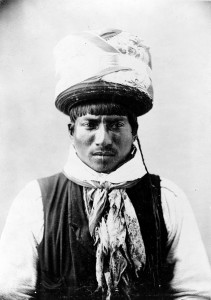
Good morning POU Family. We are officially officially 24 days away from Thanksgiving, and this week’s open threads will focus on notable notable Black Indians.
Black Indians are people of African-American descent, usually with significant Native American ancestry, who also have strong ties to Native American culture, social, and historical traditions. Many Indigenous peoples of the Eastern Woodlands today have extensive African descent, such as the Narragansett, Pequot, Lumbee, and others.
Certain Native American tribes had close relations with African Americans, especially those where slavery was prevalent. Members of the Five Civilized Tribes held enslaved blacks, who migrated with them to the West in 1830 and later. In peace treaties with the US after the American Civil War, the tribes, which had sided with the Confederacy, were required to emancipate slaves and give them full citizenship rights in their nations. The Cherokee, Creek, and Seminole have created controversy in recent decades as they tightened rules for membership in their nations and excluded Freedmen who did not have at least one Native American ancestor on the early 20th-century Dawes Rolls. The Chickasaw Nation never extended citizenship to Chickasaw Freedmen.
Until recently, historic relations between Native Americans and African Americans were relatively neglected in United States history studies. At various times, Africans had more or less contact with Native Americans, although they did not live together in as great number as with Europeans. African slaves brought to the United States and their descendants have had a history of cultural exchange and intermarriage with Native Americans and other slaves who possessed Native American and European ancestry. Most interaction took place in the Southern United States, where slaves were held in greatest number. Numerous African Americans thus have some Native American ancestry, although not all have current social, cultural or linguistic ties to Native peoples.
Relationships among different Native Americans, Africans, and African Americans have been varied and complex. Some groups were more accepting of Africans than others and welcomed them as full members of their respective cultures and communities. Native peoples often disagreed about the role of ethnic African people in their communities. Other Native Americans saw uses for slavery and did not oppose it for others.
After the American Civil War, as members of the US Army, some African Americans fought against Native Americans, especially in the Western frontier states. Their military units became known as the Buffalo Soldiers. Black Seminole particularly were recruited and worked as Native American scouts for the Army. On the other hand, many Native Americans and people of African descent fought alongside one another in armed struggles of resistance against U.S. expansion into Native territories, as in the Seminole Wars in Florida, as well as resistance against slavery and racism.
Billy Bowlegs III, Billy Fewell, aka Cofehapkee (1862–1965), was a Seminole elder, also of African-American descent. He was a tribal historian in Florida.
He was named Billy Fewell by his African-American father and Seminole mother. Fewell was also known by his Seminole name, Cofehapkee. He learned the cultural ways of the Seminole from his mother’s family and elders. His maternal grandfather was Osceola, and he was a member of the Snake Clan. After it was established, Bowlegs lived on the Brighton Seminole Indian Reservation, near Lake Okeechobee in present day Glades County.
As an adult, he renamed himself after Billy Bowlegs (Holata Micco), the prominent Seminole chief during the Seminole Wars. A Black Indian, Bowlegs became an elder in the tribe. He learned and taught much about its history. Bowlegs befriended Jame Mallory and Minnie Moore Willson, who moved to Florida in the early 1880s. They became advocates for the Seminole. The couple described him in their book, The Seminole of Florida, 1896. He wanted to improve their understanding of the tribe’s culture. The Willsons helped gain approval in 1913 by the Florida state legislature for a 100,000-acre (400 km2) reservation for the Seminole in the Everglades. They testified on their behalf to the federal government in hearings in 1917. In the mid-1950’s, he performed traditional dances at the Florida Folk Festival in Union County, on the Suwanee River.
Bowlegs was buried in Ortona Cemetery in Ortona, Florida.
A historical marker honors Billy Bowlegs III, also known as Chufi Hajo, near Moore Haven. It is located at the intersection of U.S. 27 and State Road 78. It was erected by the Polk CountyHistorical Society and the Seminole Tribe.


